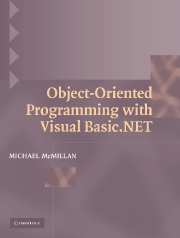Book contents
- Frontmatter
- Contents
- Preface
- Chapter 1 An Overview of the Visual Basic.NET Language
- Chapter 2 An Overview of Object-Oriented Programming
- Chapter 3 Structures
- Chapter 4 Classes
- Chapter 5 Access Modifiers
- Chapter 6 Abstract Classes and Interfaces
- Chapter 7 Implementing the IEnumerable and IComparable Interfaces
- Chapter 8 Designing and Implementing Exception Classes
- Chapter 9 Design Patterns and Refactoring
- Chapter 10 Object Internals: Reflection and Attributes
- Chapter 11 Object Persistence: Serialization
- Chapter 12 Building a Windows Application
- Chapter 13 Database Programming Using ADO.NET
- References
- Index
Chapter 12 - Building a Windows Application
Published online by Cambridge University Press: 06 July 2010
- Frontmatter
- Contents
- Preface
- Chapter 1 An Overview of the Visual Basic.NET Language
- Chapter 2 An Overview of Object-Oriented Programming
- Chapter 3 Structures
- Chapter 4 Classes
- Chapter 5 Access Modifiers
- Chapter 6 Abstract Classes and Interfaces
- Chapter 7 Implementing the IEnumerable and IComparable Interfaces
- Chapter 8 Designing and Implementing Exception Classes
- Chapter 9 Design Patterns and Refactoring
- Chapter 10 Object Internals: Reflection and Attributes
- Chapter 11 Object Persistence: Serialization
- Chapter 12 Building a Windows Application
- Chapter 13 Database Programming Using ADO.NET
- References
- Index
Summary
A Windows application is by necessity written in an object-oriented manner. This chapter discusses the code generated by VS. NET when a Windows application is built. We'll examine both the code generated by VS. NET and the code created when a programmer builds an application. We will also examine how to use object-oriented principles in the code the programmer adds to the application.
As the noted computer scientist and education theorist Seymour Paper once stated, “You can't think about thinking without thinking about thinking about something.” Likewise, you can't examine building a Windows application without having a Windows application to build. To that end, the application we'll use to illustrate how object-oriented principles aid the creation of a Windows application is a basic calculator, similar to the one found in Windows. By picking a rather simple application that uses many widely employed Windows features (e.g., textboxes, buttons, and labels), we can focus on how taking an object-oriented approach makes the development easier and more efficient. We should also mention that this chapter is not designed to teach a novice how to create a Windows application; rather it teaches how to create a Windows application in an object-oriented way. We assume the reader already knows how to place controls on a form and already knows the basics of writing event-driven code.
Information
- Type
- Chapter
- Information
- Object-Oriented Programming with Visual Basic.NET , pp. 260 - 276Publisher: Cambridge University PressPrint publication year: 2004
